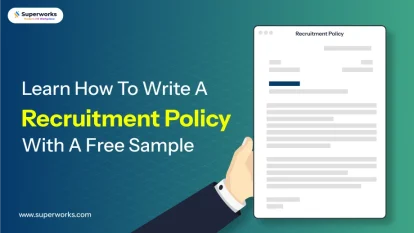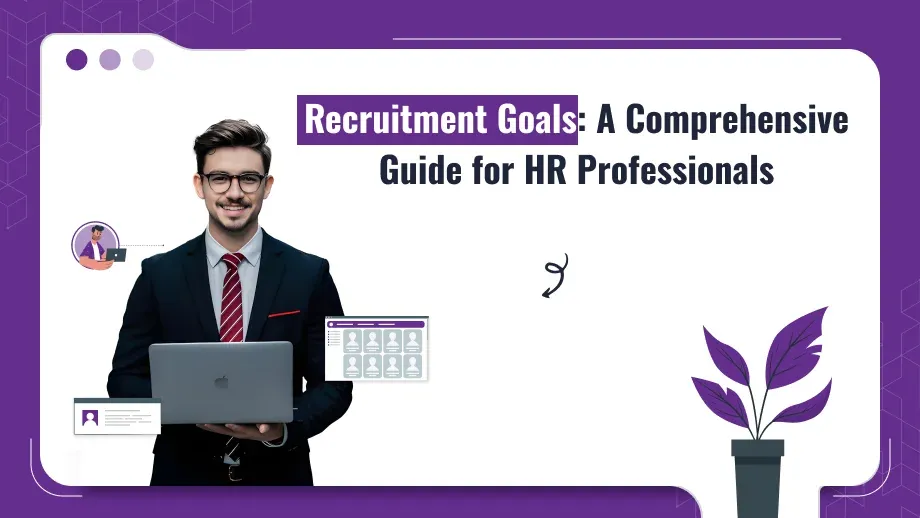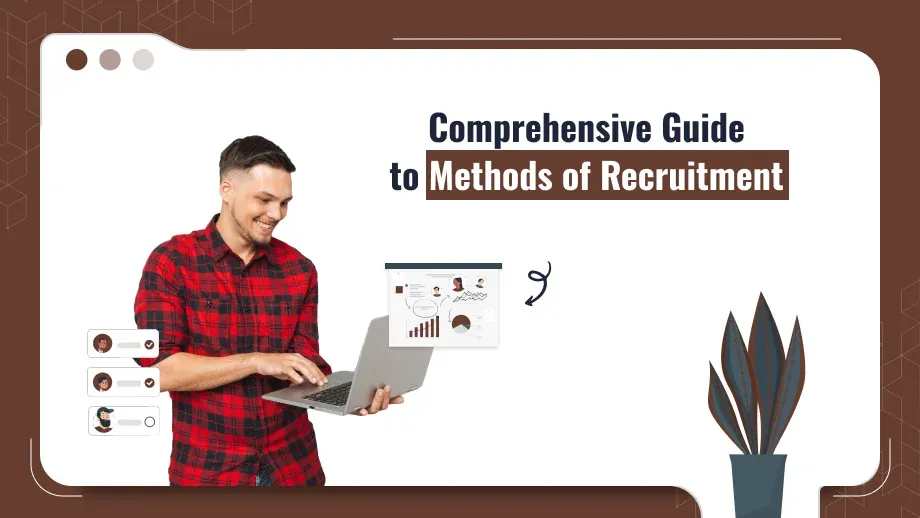An employee referral program is a structured initiative implemented by organizations to encourage their employees to recommend potential candidates for job openings within the company. It incentivizes employees to refer individuals from their professional networks, offering rewards or bonuses for successful referrals.
Grab a chance to avail 6 Months of Performance Module for FREE
Book a free demo session & learn more about it!
-
Will customized solution for your needs
-
Empowering users with user-friendly features
-
Driving success across diverse industries, everywhere.
Grab a chance to avail 6 Months of Performance Module for FREE
Book a free demo session & learn more about it!
Superworks
Modern HR Workplace
Your Partner in the entire Employee Life Cycle
From recruitment to retirement manage every stage of employee lifecycle with ease.


Seamless onboarding & offboarding
Automated compliance & payroll
Track performance & engagement
Grow Your Team Better, Faster With An Employment Referral Program
- referral program software
- 14 min read
- June 16, 2023

Are you tired of sifting through piles of resumes and conducting endless interviews, only to find that none of the candidates truly meet your expectations? What if there was a proven method to grow your team better and faster, with candidates who are already vetted by trusted sources?
Look no further!
In this blog, we unveil the untapped potential of an Employment Referral Program. By leveraging the power of your existing employees’ networks, you can tap into a vast pool of top-notch talent, saving time and resources in the process.
Get ready to revolutionize your recruitment strategy and witness the remarkable benefits of an Employee Referral Program.
- What is an employee referral program?
- Why is Employee Referral Program Important For Businesses?
- 5 Myths About Employee Referral Programs
- Myth : An employment referral program leads to a decrease in diversity.
- Myth : Only low-quality candidates come through an employment referral program.
- Myth : An employment referral program creates nepotism within the organization.
- Myth : An employment referral program discourage external hiring.
- Myth : Employees only refer their friends or family members.
- How Can You Create An Employ Define Program Objectives:
- Must-Know Benefits of Employee Referral Programs
- 3 Tips For Creating An Employment Referral Program
- 7 Brilliant Employment Referral Programs Examples
- Conclusion
What is an employee referral program?
An employee referral program is a structured initiative implemented by a company to encourage its employees to refer qualified candidates for job openings within the organization.
It typically involves rewarding employees who refer successful hires, either through financial incentives, recognition, or other perks.
Employee referrals are considered valuable because they often result in higher-quality candidates who fit well with the company culture and are more likely to stay in the long term. This type of program leverages the network and knowledge of existing employees to attract talented individuals, making the recruitment process more efficient and effective. This means, you can use referral programs for employees as well as candidates – it benefits both!
Now that you know what is an employee referral program, let’s know its importance!
Why is Employee Referral Program Important For Businesses?
Having an employee referral program is important for all businesses, be it small, medium or large businesses.
Referrals boost employee morale and engagement, reduce recruitment costs and turnover rates and much more.
On the other hand, without an employee referral program, businesses may struggle to attract top talent and rely solely on traditional recruiting methods, which can be time-consuming and yield less suitable candidates.
Moreover, the absence of such a program can result in higher recruitment costs, lower employee satisfaction, and missed opportunities to tap into employees’ networks for potential hires.
5 Myths About Employee Referral Programs
There are some common myths associated with the employment referral program. Let’s debunk five of these myths:
Myth : An employment referral program leads to a decrease in diversity.
Reality :
While it’s true that relying solely on employee referrals may result in a lack of diversity, companies can actively implement strategies to mitigate this issue.
For example,organizations can establish diversity goals, provide unconscious bias training to employees involved in the referral process, and use targeted outreach efforts to attract diverse candidates.If you still want to ensure unbiased and diversity while hiring, you can rely on automated software such as Applicant Tracking Systems, referral program software, and more. Such solutions leave no room for bias or unfair decisions.
Myth : Only low-quality candidates come through an employment referral program.
Reality :
Employee referrals often lead to high-quality candidates. Employees tend to refer individuals who they believe will succeed and contribute positively to the company.
Referrals can reduce time-to-hire and increase retention rates, as candidates are pre-screened by trusted employees who understand the company culture and requirements
Myth : An employment referral program creates nepotism within the organization.
Reality :
A well-designed employee referral program operates based on merit.
While referrals provide an opportunity for employees to recommend someone they know, the final hiring decision should always be based on the candidate’s qualifications, skills, and fit for the role. It is essential for companies to establish a fair and transparent selection process to avoid any perception of nepotism
Myth : An employment referral program discourage external hiring.
Reality :
An employment referral program is not meant to replace external hiring; it is designed to supplement it.
While referrals can be a valuable source of candidates, organizations should still actively seek external talent through various channels to ensure a diverse and robust candidate pool.
Myth : Employees only refer their friends or family members.
Reality :
While it’s true that employees may refer friends or family members, they also refer individuals they have worked with in the past or professionals they have encountered through industry events and networking.
An employment referral program can tap into an employee’s professional network, expanding the reach of potential candidates beyond personal relationships.
How Can You Create An Employ Define Program Objectives:
1. Define Program Objectives:
Defining program objectives is crucial in creating an employee referral program. Objectives may include improving hiring quality by targeting specific skills and cultural fit, boosting employee engagement through incentives and recognition, and reducing time and cost per hire. Clear objectives provide direction and ensure the program aligns with organizational goals.
2. Set Program Guidelines:
Setting clear program guidelines is also equally essential for the successful implementation of an employee referral program. These guidelines establish the framework and expectations for employees participating in the program.
Key elements to consider when setting program guidelines include defining eligible positions, outlining referral eligibility criteria, specifying the referral submission process, determining reward structures, and establishing any program limitations or exclusions.
Clear and transparent guidelines ensure consistency, fairness, and an understanding of the program’s parameters among employees, promoting active participation and successful outcomes.
3. Develop the Referral Process:
Developing a streamlined and efficient referral process is a crucial step in creating an employee referral program. Define a clear and user-friendly process for employees to submit referrals, including the required information and documentation.
Consider using an online applicant tracking system or dedicated Recruitment software to facilitate the submission and tracking of referrals. Additionally, establish a structured evaluation and follow-up process to ensure timely feedback and communication with both the referring employee and the referred candidate. A well-developed referral process promotes employee engagement and increases the chances of successful hires through the program.
4. Communicate the Program:
Inform your employees about the referral program and its benefits. Utilize multiple communication channels such as email, intranet, team meetings, and posters to raise awareness. Clearly explain the program guidelines, rewards, and how the referral process works.
5. Train Managers & Employees:
Provide training to managers and employees on how to effectively participate in the referral program. Educate them on the qualities and skills the company is looking for and how they can identify potential candidates.
6. Establish a Fair Evaluation Process:
Develop a fair and transparent Employee Evaluation process for referred candidates. Clearly define the criteria for assessing referrals and ensure that the selection process is objective and unbiased. Avoid favouritism and ensure that all referrals are given equal consideration.
7. Reward & Recognition:
Determine the rewards or incentives for successful referrals. This can include monetary bonuses, gift cards, extra paid time off, or other forms of recognition. Make sure the rewards are attractive enough to motivate employees to actively participate in the program.
8. Track & Measure Results:
Implement a system to track and measure the results of the referral program. Monitor the number of referrals received, the quality of candidates referred, and the number of successful hires. Use this data to evaluate the effectiveness of the program and make any necessary adjustments.
9. Provide Feedback & Updates:
Keep employees informed about the progress of the referral program. Provide regular updates on the number of successful hires, share success stories, and acknowledge employees who have made valuable referrals. This helps to maintain engagement and enthusiasm among employees.
10. Continuously Improve:
Regularly review and refine your referral program based on feedback and results. Solicit feedback from employees to identify areas for improvement and make adjustments accordingly. A successful employee referral program is an ongoing process that requires continuous evaluation and enhancement.

Want to source and hire top talent for your team? You Can!
If you said YES, you must try Super Recruit- the ultimate solution to a simplified & faster recruitment process. From job posting to career page builder, you will get everything you need to attract the best talent.
Start your transformative journey by taking a 30 days free trial in just a click!
Must-Know Benefits of Employee Referral Programs
Prioritizing an employment referral program can bring numerous benefits to an organization. Here are several reasons why you should prioritize such a program
1. Quality Candidates:
Employee referrals often result in higher-quality candidates compared to other recruiting methods. Employees tend to refer individuals who are qualified, capable, and align with the company culture. These candidates are more likely to succeed and contribute positively to the organization.
2. Cost & Time Efficiency:
Implementing an employee referral program can significantly reduce recruitment costs and save time. Traditional hiring methods, such as advertising job postings or using external recruiters, can be expensive and time-consuming. By leveraging your employees’ networks, you tap into a wider pool of potential candidates without incurring additional costs
3. Increased Employee Engagement & Retention:
Encouraging employees to participate in the referral program boosts their engagement and sense of belonging. They become active contributors to the company’s growth and success. Additionally, employees who refer candidates are more likely to stay engaged and committed to the organization.
4. Cultural Fit:
Employees who refer their acquaintances or friends have a good understanding of the company culture. This familiarity helps ensure that referred candidates are more likely to fit in well with the existing team and align with the company’s values and objectives.
5. Faster Hiring Process:
An employment referral program can expedite the hiring process. Referred candidates often have a shorter time to hire since they come with a pre-existing connection to an employee. This reduces time spent on sourcing, screening, and interviewing candidates, allowing you to fill positions more quickly.
6. Reduced Turnover:
Referred candidates tend to have higher job satisfaction and lower turnover rates. When employees are involved in the hiring process and refer candidates they trust, they feel a greater sense of responsibility for the new hire’s success. This sense of accountability can lead to stronger employee retention rates.
7. Improved Diversity & Inclusion:
An employee referral program, when implemented correctly, can contribute to improving diversity and inclusion within an organization. By encouraging employees to refer candidates from diverse backgrounds, you broaden the talent pool and create opportunities for underrepresented groups.
8. Positive Employer Branding:
A successful referral program enhances your organization’s employer brand.
When employees actively participate and refer their connections, it reflects positively on the company’s culture, work environment, and employee satisfaction. This, in turn, attracts more potential candidates who are drawn to a company with a strong reputation.
There are more employee referral program benefits, but aforementioned are the top ones!
3 Tips For Creating An Employment Referral Program
Here are three tips to help you create a successful employee referral program:
1. Clear Guidelines and Communication :
Provide your employees with clear guidelines on the referral program, including eligibility criteria, the types of positions that qualify, and the referral process.
Make sure to communicate these guidelines effectively through company-wide emails, internal newsletters, and even in-person meetings to ensure everyone is aware of the program.
As we already mentioned earlier, you can choose one of the most suitable Applicant Tracking Systems for your employee referral program. Such systems not just enable free job posting,real-time Reporting and recruitment sourcing tools but also offer.
2. Simplify the Referral Process :
Make the referral process as simple and user-friendly as possible. Consider implementing an online referral portal or dedicated email address where employees can easily submit their referrals.
Minimize the paperwork and administrative burden associated with the process to encourage more employees to participate.
3. Timely Feedback & Follow-up :
Provide timely feedback and follow-up to employees who make referrals.
Keep them informed about the progress of their referred candidates, whether they are selected for interviews or eventually hired. This not only shows transparency but also reinforces the value of their contributions and encourages ongoing participation.
7 Brilliant Employment Referral Programs Examples
Here are programs that will help you create an effective employment referral program for your company:
1. PURE
The American property insurance company, PURE, boasts a remarkable referral rate with a significant portion of their workforce, ranging from 40% to 60%, being recruited through referrals.
What’s their secret?
They waste no time. Once a new employee successfully completes their initial weeks at PURE, they are promptly asked if they are acquainted with individuals who would excel within the company.
This direct and straightforward referral approach offers two primary advantages: Firstly, it immediately generates a higher number of referrals. Secondly, it underscores the significance of referring potential candidates.
2. Salesforce’s happy hours
Salesforce, the prominent US cloud computing giant, is renowned for its generous rewards, encompassing financial incentives and more, which it offers to its employees. These benefits extend beyond successful referrals.
Salesforce ensures that its staff members have access to mindfulness rooms, encourages paid volunteering in the community, and provides assistance in finding new challenges if they have not received a promotion in 18 months.
Speaking of referrals, Salesforce has compensated its employees with an impressive sum of over $5.5 million in referral bounties.
Now, let’s delve into Salesforce’s approach to their referral program.
The company hosts Recruitment Happy Hours, informal gatherings where employees can invite individuals they wish to refer. These events offer an excellent opportunity for recruiters to connect with potential candidates in a relaxed setting. Moreover, it adds an element of enjoyment for both the employees and their referrals, who can bond over a few drinks together.
3. InMobi’s Bikes
When InMobi, a global mobile advertising and discovery platform, faced a pressing need for engineering managers, their hiring team understood the importance of devising an extraordinary solution.
And that’s precisely what they did.
They crafted country and culture-specific incentives to reward their employees. In India, this translated into the allure of a Royal Enfield bike (reminiscent of the Harley Davidson in India), while in the US, it meant the excitement of owning a Vespa.
To maintain employee motivation and engagement in the referral process, these coveted vehicles were strategically placed at the entrance of the offices. For each successful referral, InMobi’s employees were given the choice between receiving a brand-new bike or embarking on an enticing trip to Bali.
This clever incorporation of local knowledge to tailor the employee referral program yielded remarkable results. InMobi witnessed a remarkable surge in their referral rate, soaring from 20% to an impressive 50% for a company with 900 employees.
4. Fiverr
Fiverr, a prominent freelancing marketplace, sought to enhance employee referrals by implementing a strategy that involved monitoring social job sharing and introducing gamification elements. They devised a system where employees would earn points for sharing job openings and referring their friends.
To execute this plan effectively, Fiverr opted to utilize Zao, a company specializing in employee referral programs (now acquired by PIXID). This software introduced a competitive aspect to the process of recommending candidates by awarding employees points and recognition for their actions. Additionally, it ensured that employees remained informed about any updates regarding the status of their referrals.
Based on their performance on the Zao referral leaderboard, the highest-performing Fiverr employees were rewarded with gifts on a quarterly and yearly basis, providing an extra incentive for active participation in the referral program.
5. Google
When discussing examples of employee referral programs, Google exemplifies the effectiveness of simplicity. Recruiters at Google employ a straightforward approach by posing specific questions to their employees, such as, “Who do you consider the top software developer in Boston?”
This deliberate questioning technique encourages individuals to delve deeper and carefully consider the individuals they recommend, prompting them to think more critically about their referrals.
6. Accenture
Accenture, a Dutch consulting and IT firm, adopts a unique approach in its employee referral program. Recognizing the intrinsic satisfaction derived from referring others, Accenture emphasizes the positive impact of helping both friends secure employment management and the company discover exceptional talent.
To amplify this sense of fulfillment, Accenture offers its employees the opportunity to donate a portion of their referral bonus to a charity of their preference. Furthermore, to enhance this initiative, the company matches the donated amount, further magnifying the impact of their employees’ generosity.
7. Intel
Intel has devised a simple yet effective approach to address two crucial goals simultaneously. In their commitment to prioritize diversity in hiring, the American tech giant implements a strategy where they amplify the referral bonus when employees successfully refer women and minorities. This incentivized initiative not only encourages employees to actively participate in the referral program but also promotes diversity within the company’s workforce.
Conclusion
In essence, an employment referral program is a valuable tool for growing your team quickly and effectively.
By leveraging the networks and recommendations of your existing employees, you can tap into a pool of qualified candidates who are more likely to align with your company’s culture and values. This approach not only streamlines the hiring process but also boosts employee engagement and loyalty. With employee referral programs in place, you can build a strong and talented team that propels your organization towards success.
So, are you ready to leverage the benefits of employee referral programs?
Also See: Employee rewards
FAQs
1. What is an employment referral program?
2. Why should a company have an employee referral program?
An employment referral program has several benefits for companies. Firstly, they often result in higher-quality candidates as referrals come from trusted sources. Additionally, an employment referral program can reduce recruitment costs as well as shorten the hiring process. Moreover, they boost employee engagement, satisfaction, and retention by involving employees in the recruitment process and recognizing their contributions.
3. How do employee referral programs work?
Employees refer candidates, HR reviews the referrals, and if a referral leads to a successful hire, the employee receives a reward.
4. What are common incentives or rewards in employee referral programs?
Incentives in employee referral programs vary from company to company. Common rewards include cash bonuses, gift cards, extra vacation days, recognition events, or even larger rewards for particularly hard-to-fill positions. Some companies also offer tiered rewards, where the value increases based on the seniority of the referred candidate or the number of successful referrals made by an employee.
5. How can companies ensure the success of their employee referral programs?
To maximize the effectiveness of an employee referral program, companies can consider several strategies such as clear communication, engaging incentives, regular reminders, a streamlined process, and timely feedback to employees.










